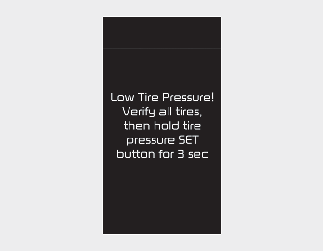Indication of Low Tire Pressure

The ( ) warning light will illuminate when an under-inflated tire is indicated. In certain types, the above message might be displayed
on the cluster.
) warning light will illuminate when an under-inflated tire is indicated. In certain types, the above message might be displayed
on the cluster.
If the warning light illuminates, reduce your speed, avoid hard cornering and rapid braking. Have your vehicle inspected by a professional workshop. Kia recommends to visit an authorized Kia dealer/service partner.
Check the pressure of all tires and inflate to the proper pressure according to procedures, and if required, replace or repair the tires.
If you cannot reach a close service station, stop the vehicle at a safe place, check all tires and operate the TPMS reset procedure. If you are unable to adjust the tire pressure, use the repair tools to repair or change to spare tire and contact a professional workshop.
Kia recommends to call an authorized Kia dealer/service partner.
You may not be able to identify low tire pressure visually. Use precise tools to measure and adjust tire pressure. Please note that a tire that is hot due to prolonged driving, therefore will have high pressure. We recommend you to measure and adjust the tire pressure after the vehicle has driven for less than 1.6 km (1 mile) within 3 hours.

-
The indicator may remain illuminated after changing to a spare tire, because radius of spare tire is different. Be sure to change to a regular tire.
-
For safe driving, please note that the TPMS is not a substitute for proper tire maintenance. It is the driver’s responsibility to maintain correct tire pressure, and all tires should be checked monthly to maintain the recommended pressure.
-
The warning light may illuminate if the system is not set in required situations.
-
In cold weather, the low tire pressure warning light may illuminate even if the tire was adjusted to the proper pressure. It does not mean your TPMS in malfunctioning because the decreased temperature leads to a lowering of tire pressure. Check the tires and adjust to the recommended pressure.
-
System performance may reduce in the following situations.
-
Do not reset TPMS properly
-
Using tires on the market (Original tire recommended)
-
Driving on snowy, slippery, or unpaved roads
-
Hard cornering, rapid accelerating and braking repeatedly
-
Driving too slow or fast
-
If the vehicle is overloaded
-
If a spare tire or snow chain is installed
-
-
When filling tires with more air, conditions to turn off the low tire pressure telltale may not be met. This is because a tire inflator has a margin of error in performance. The low tire pressure telltale will be turned off if the tire pressure is above the recommended tire inflation pressure.

-
Driving with an under-inflated tire causes the tire to overheat and lead to tire failure. It also reduces tire tread life, handling of the vehicle, braking ability, and fuel efficiency, causing instability of the vehicle. In this case, contact professional workshop to maintain proper tire pressure. Kia recommends to contact an authorized Kia dealer/service partner.
-
Sudden damage to the tire caused by external factors may not be indicated immediately. If the vehicle is unstable, immediately remove your foot off the accelerator pedal, move the vehicle to a safe position for inspection.

Low pressure damage
Significantly low tire pressure makes the vehicle unstable and can contribute to loss of vehicle control and increase braking distances. Continued driving on low pressure tires can cause the tires to overheat and fail.